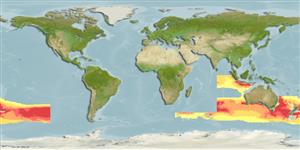>
Zeiformes (Dories) >
Oreosomatidae (Oreos) > Oreosomatinae
Etymology: Neocyttus: Greek, neos = new + Greek, kyttaros, kytos = a convex cavity; psilorhynchus: Named for the naked area on the snout..
More on authors: Yearsley & Last.
Environment: milieu / climate zone / depth range / distribution range
Ekologi
laut batipelagis; kisaran kedalaman 750 - 1170 m (Ref. 30191). Deep-water
Indo-West Pacific: southwestern Australia, Tasmania and along Clatham Rise, east of New Zealand.
Size / Weight / umur
Maturity: Lm ? range ? - ? cm
Max length : 22.4 cm SL jantan/; (Ref. 30191)
Found on the continental slope, benthic (Ref. 75154).
Life cycle and mating behavior
Kematangan | Reproduksi, perkembang biakan | Pemijahan | telur-telur | Fecundity | Larva
Yearsley, G.K. and P.R. Last, 1998. Neocyttus psilorhynchus, a new oreosomatid (Pisces, Zeiformes) from southern Australia and New Zealand, with redescriptions of its congeners. N.Z. J. Mar. Freshwat. Res. 32(4):555-579. (Ref. 30191)
Status IUCN Red List (Ref. 130435)
ancaman kepada manusia
Harmless
penggunaan manusia
informasi lanjut
Nama-nama umumSinonim (persamaan)metabolismePemangsaEkotoksikologiReproduksi, perkembang biakanKematanganPemijahanSpawning aggregationFecunditytelur-telurpekembangan telor
Umur / Saiz
Pertumbuhan
panjang-berat
panjang-panjang
ukuran frekuensi
Morfometrik
Morfologi
Larva
Dinamika larva
pemulihan
Kelimpahan
BRUVS
AcuanBudidaya airprofil budidaya airStrainGenetikaElectrophoresesDiturunkanPenyakit-penyakitPengolahanNutrientsMass conversion
mitraGambarStamps, Coins Misc.Suara-suaraCiguateraKecepatanTipe renangArea insangOtolithsOtakPenglihatan / visi
Alat, peralatan
laporan khas
muat turun XML
Sumber internet
Estimates based on models
Preferred temperature (Ref.
123201): 2 - 2.9, mean 2.1 °C (based on 4 cells).
Phylogenetic diversity index (Ref.
82804): PD
50 = 0.5635 [Uniqueness, from 0.5 = low to 2.0 = high].
Bayesian length-weight: a=0.01622 (0.00733 - 0.03589), b=3.03 (2.83 - 3.23), in cm total length, based on LWR estimates for this (Sub)family-body shape (Ref.
93245).
Trophic level (Ref.
69278): 3.5 ±0.5 se; based on size and trophs of closest relatives
Daya lenting (Ref.
120179): sangat rendah, Waktu penggandaan populasi minimum lebih dari 14 tahun (Preliminary K or Fecundity.).
Fishing Vulnerability (Ref.
59153): Low vulnerability (17 of 100).
